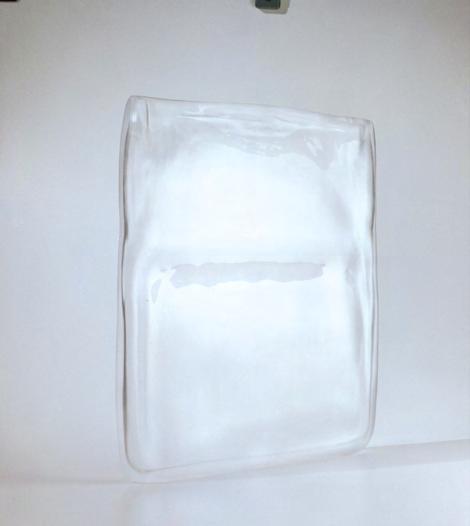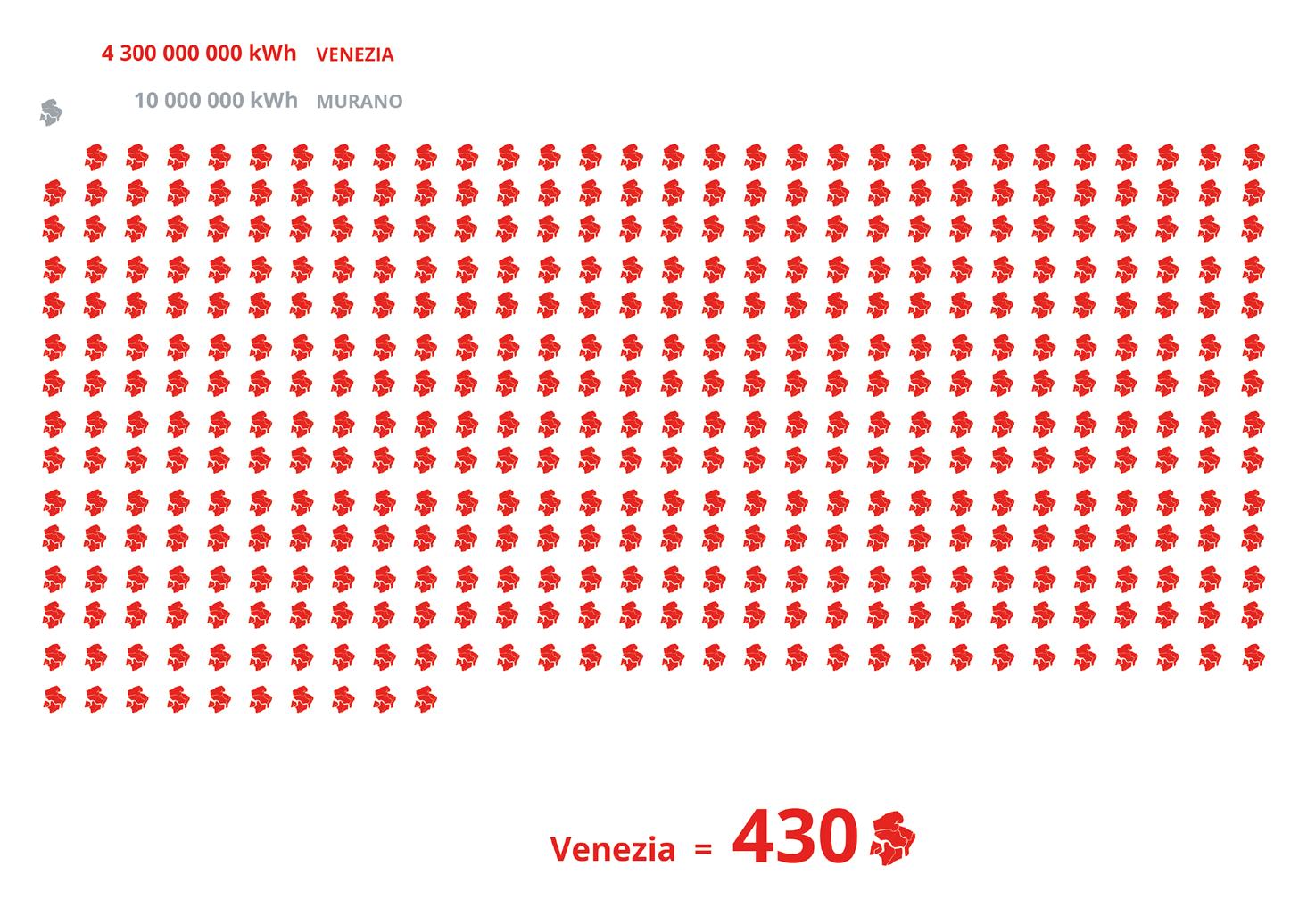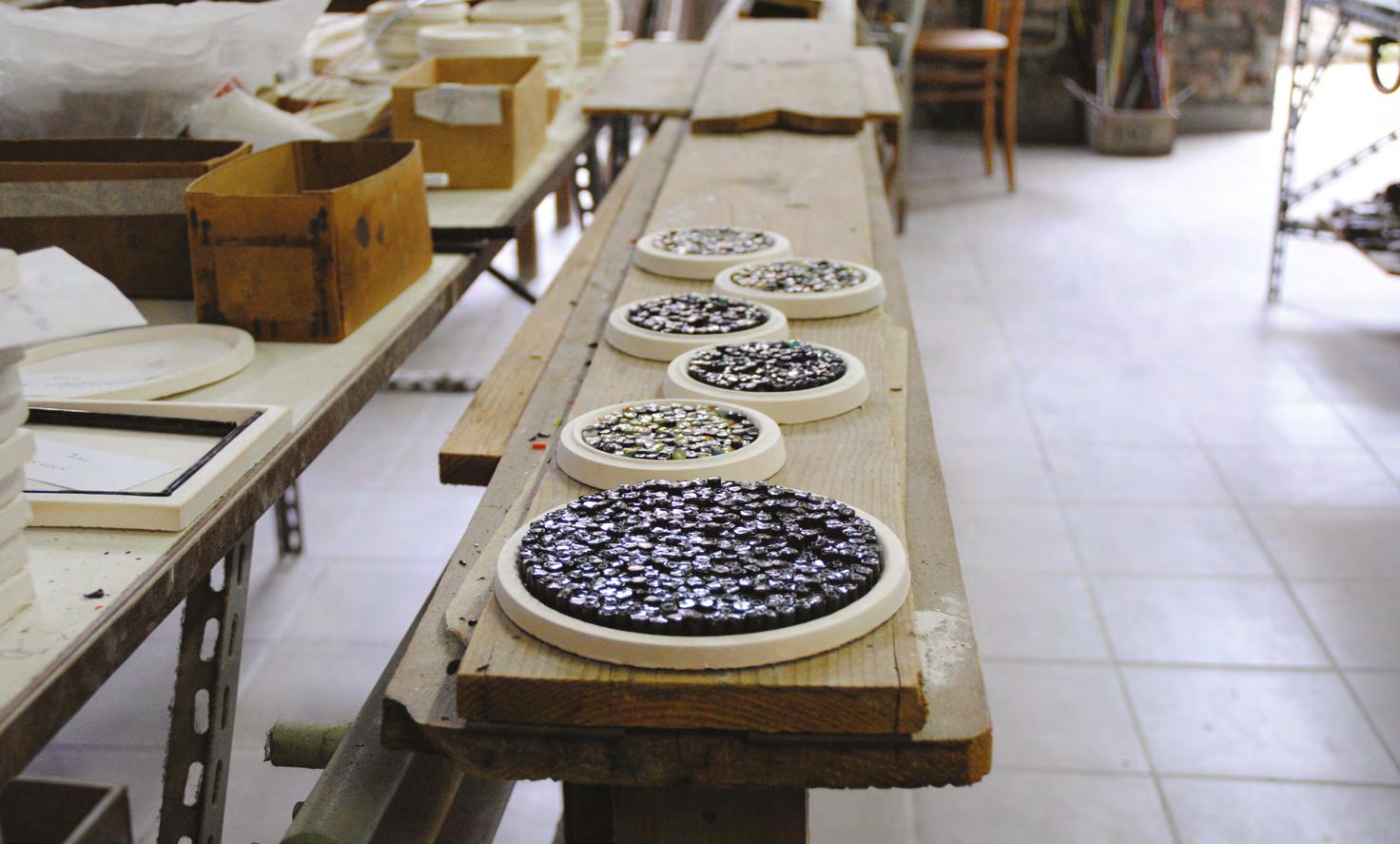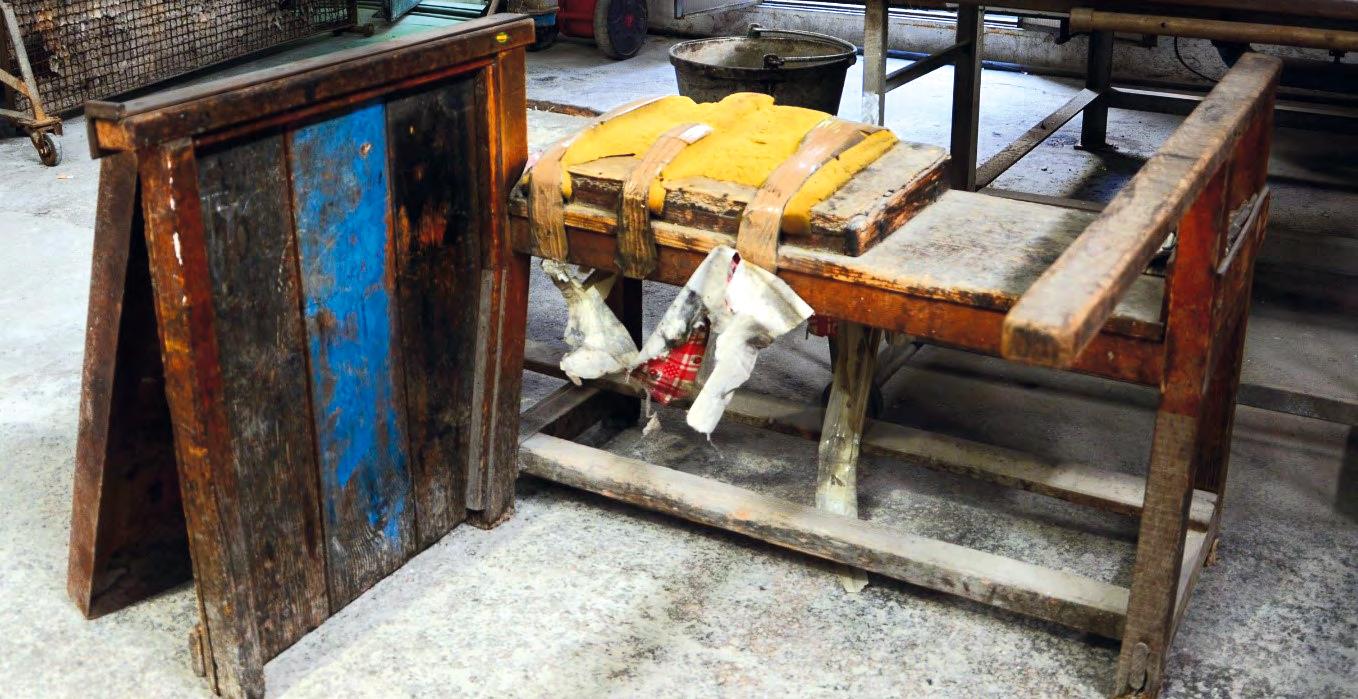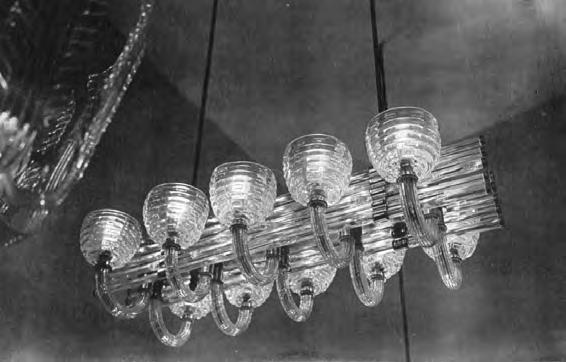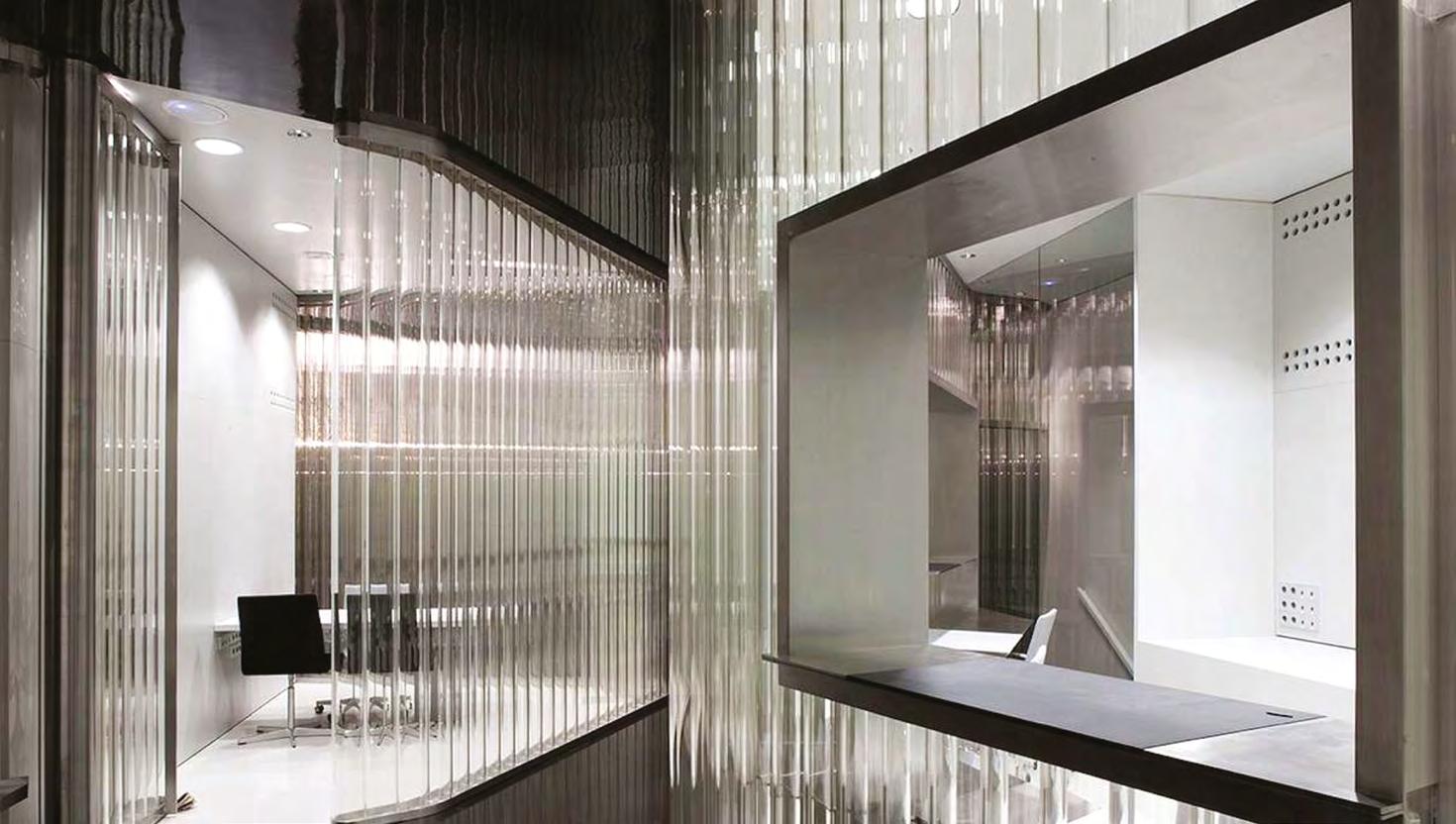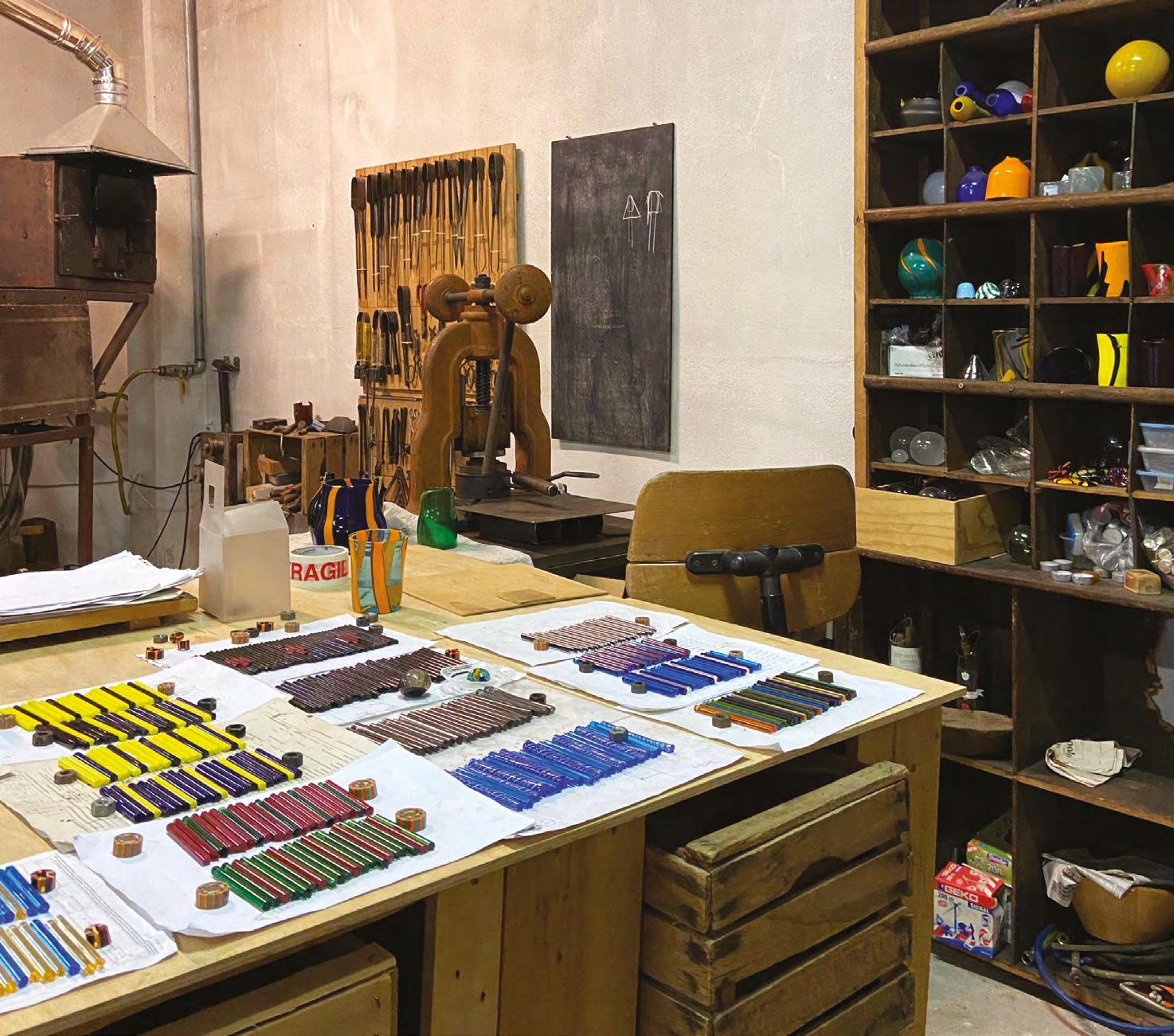
16 minute read
Glass on stage. The woman of fire Marietta Barovier
MASSIMILIANO CIAMMAICHELLAA
Starting from an attentive historical recognition of glass manufacture, the paper traces the salient stages of female entrepreneurship in fifteenth Century Murano, focusing on the pioneering figure of Marietta Barovier. The theatrical production, dedicated to her, updates her cultural fundament, knowledges, actions, and life, through a performance in constant dialogue between past and present, in which the stage setting is made up of morphing videos that continuously shape the glass matter. This experience is part of candidacy dossier for the venetian pearls as UNESCO intangible heritage, to help raise awareness and spread the transmission of know-how, the dissemination of which here is confronted with the theatre democratic space.
A Department of Architecture and Arts, Università Iuav di Venezia, Venice.
KEYWORDS: DIGITAL SET DESIGN, THEATER, ROSETTA BEAD
Introduction
In the Serenissima history, the fifteenth Century was undoubtedly a Century of fundamental cultural and productive changes that relaunching Murano as undisputed innovation capital in the glassmaking art that began to be such in its transition from mass production, for purely utilitarian purposes, to elite production, aimed at a public that appreciates the aesthetic value and the workmanship finesse. Proof of this is the confirmation decreed in 1441 of the Fiolèr1 professional figure substitution – documented in the thirteenth Century Capitolare – with that of the glass worker, described in the statute of “Mariegola dell’Arte dei Verierieri da Muran” (Gasparetto, 1988).
In this period, the intervention areas ranged from the construction of large architectural stained-glass windows, as for example happen in the SS. Giovanni e Paolo church in Venice, to the crystal mirrors experimentation, to the empirical and alchemic reworking of tricks, searching for alternative formulas in the coloring of increasingly transparent and homogeneous surfaces, on which further decorations made of enamel paint could be applied.
The raw materials were silica sand, obtained from the hot grinding of quartzrich pebbles, the most valuable of which came from the Ticino River; then coloring pigments or decoloring agents were added, and finally, melting agent, commonly known as Allume catino2: an ash with a high sodium content derivatives from the combustion of littoral plants. The most popular was Syriac (Zecchin, 1997).
Glassworks were generally equipped with three furnaces. The first, also known as the Calchera3, had only one chamber and was assigned to melting the above-described components, to produce the Fritta4, a raw and dense glass with impurities, which was undergo cooling and shattering processes in order to be recast in the second furnace, inside crucibles; it was then poured into the water several times to free it of residual impurities.
Subsequently, blocks for working were produced whose malleable plasticity allowed the extraction of portions to be shaped with blow pipes, tools for cutting and bending. Once the final shape was achieved, it was placed back in the third furnace for work completion (Marascutto and Steiner, 1991).
In this complex sequential procedure, played out on the limits of a challenge between rule and its refinement, alchemical practices were perpetuated to generate artifacts influenced by the tinkling aesthetics, traceable to the durability logics of a fragile and light malleable material.
1 Fiolèr or Fiolaro: Dialect term derived by “fiola”, a narrow-necked liquid vessel. 2 Allume catino: commercial potash or potash sub-carbonate, in Murano furnaces its processing involved alchemical purification of soda ashes. 3 Calchera: oven with two overlapping chambers. In the lower one, named Castra, firewood was placed, and in the upper one, Fritta was prepared. 4 Fritta: silica and melting agent are mixed at the bottom of the Calchera, forming a kind of crumbly, shapeless mound. It constitutes the first phase of the actual fusion.
Fig. 01 La Donna del Fuoco Marietta Barovier. Pioniera delle perle veneziane. Direction and dramaturgy: M. Navone, scenic and video staging: M. Ciammaichella, Goldoni Theater, Venice, September 12, 2021.
Glass Innovation and Renaissance
Among the most important protagonists of the fifteenth Century scene, Angelo Barovier is the one who certainly made significant innovations in the field of glassmaking.
As member of one of the historic families of glassmakers, active in Murano since the thirteenth Century, he was trained in the school of San Giovanni Elemosinaro in Rialto, with the mentor, philosopher, and mathematician Paolo dalla Pergola. We learn this from a manuscript document, collected and published by Emmanuele Antonio Cicogna, in which it is stated that the master gave lessons to an “egregium ex primariis Muriani Angelum nominee” (Cicogna, 1853, p. 467), especially regarding the compositions and secrets of glass coloring.
Other statements see him as a protagonist in the ideal city of Sforzinda design, described by Antonio di Pietro Averlino, the Filarete – in his Trattato di architettura composed between 1451 and 1458 – as a sculptor and goldsmith in the service of Milan duke, whose palace and throne were to be decorated by Barovier with inlays of finest glass.
This shows how this ability to experiment with new compositions, aimed at the invention of crystalline glass, owes it precisely to Angelo Barovier to have exported outside the island first, and later to the world, prestigious products that kicked off the Renaissance of the art of glassmaking, thanks to the success of Lattimo and Calcedonio (Zecchin, 1987, II).
The first was milky white, imitating Chinese porcelain, and was obtained by opacifying crystal with lime of lead and tin. Calcedonio glass, on the other hand, recalled the veining of agate, onyx, and other gemstones by adding a combination of metallic compounds, such as silver salts, to the mixture. In fact, the term Lattimo already appeared in some Murano papers from 1420, but in 1452 Barovier in his furnace had succeeded in producing a transparent glass, immediately named Crystal, earning from the Signoria the concession to work it even during the period of the year when inactivity was imposed on the island’s furnaces, from mid-August to the end of October (Zecchin, 1976).
The success of crystal, however, was surely the result of empirical research whose purpose was not so much related to a nostalgic return to the fashion of colorless transparency, already produced since the Middle Ages, but rather to the nullification of impurities and imperfections, mainly due to the melting agent and soda ash that compromised the homogeneity effects of glass (Barovier Mentasti, 1982). In general, all these inventions were protected by short-lived patents and at the special request of the glass makers, to secure their economic interests, and then disseminated to other Murano furnaces after an appropriate period of time.
Actualization of Glass Beads
The protagonist of these events died at the age of 55 in 1460, leaving tangible evidence of his work that receives his surname: the Barovier Cup made of blown glass, painted with polychrome fused enamels, and dated c. 1460, now housed at the Murano Glass Museum.
The inheritance of the family business then passed to the six sons, among whom Marino stands out for his positions as Gastaldo of the glassmakers’ art in 1468 and 1482; then there is Giovanni, who manages the furnaces together with Maria, known as Marietta, who guards the secrets of her father’s craft in a special notebook he gave her and from which she draws ideas for glass compositions and colorations (Cicogna, 1853).
Not much is known about her, but she probably was born in 1431 because her mother Apollonia, in a notarial deed perhaps signed before childbirth, leaves her an inheritance of 70 ducats as a dowry for her future marriage. However, she will never marry, this seems to suggest a definite choice in devoting herself to her passion for her work and claiming a form of social redemption that sees, at last, a woman at the direction of enterprises made up exclusively of men.
Moreover, her active role as an entrepreneur is also documented by the deeds of Murano’s Podestà Francesco Dolfin, dated July 26, 1487, which declare her directing the production of enamel-painted glass, because Doge Agostino Barbarigo granted her the opening of a Muffola, a small furnace used for annealing enamels (Levi, 1895).
Other traces of her existence are dated to May 4, 1496, the day on which the inventory of unsold products from the Barovier brothers’ furnaces was drawn up, among which appear artifacts in non-blown glass and the famous Rosetta bead, of his own invention (Zecchin, 1987, II).
According to the dates given in the documents that have come down to us, at least for the Century in which she lived, the long-lived and eclectic Marietta would have worked on the Rosetta beads production in the small furnace she opened in 1487, although the term already appears in some documents dating back to 1480; in any case the 1496’s inventory refers to the Oldani, which are


Fig. 02 Frames of videos on stage for La Donna del Fuoco Marietta Barovier. Pioniera delle perle veneziane. M. CIammaichella, 2021. Fig. 03 La Donna del Fuoco Marietta Barovier. Pioniera delle perle veneziane. Direction and dramaturgy: M. Navone, scenic and video staging: M. Ciammaichella, Goldoni Theater, Venice, September 12, 2021.
ellipsoidal beads very similar to those still in production today. To make them, a pierced rod contains six layers of colored glass alternating on blue, white, and red in forming five concentric starry, twelve-pointed prisms (Sarpellon, 2003).
The process requires the labor of four or five people and begins with a metal rod being heated by a Servente inside a furnace with three crucibles, containing the colors described above.
First, the white dough is taken to be rolled around the rod on an iron plate until the cylindrical shape is obtained, then the Scagnèr intervenes by holding a pair of pliers in making a hole along the cylinder axis, which is immediately plunged into the crucible where the blue glass is, so as to form a light layer around the white. The dough retains a workable consistency as it is placed in a mold whose section has the characteristic star profile, and this procedure is repeated three more times, alternating the same number of colors, until the last cobalt blue glass covering is rolled, returning to the primary cylindrical shape. At this point the Scagnèr grabs a second iron rod and applies it to the opposite end of the first, delivering them both on the hands of two Tiradori who walk in opposite directions in extending the cylinder until the wanted diameter is reached, and then let the glass rods, cut about a meter long, cool on wooden boards (Moretti, 2005).
Among the most complex steps, grinding, which in Marietta’s time was done by hand, is a long process of abrasion and polishing designed to give the bead its characteristic ellipsoid shape, making it world-famous in becoming exchange currency. Between truth and legend, in fact, Christopher Columbus is believed to have given Rosetta beads to the American Indians, but it is certain that these were found in India by Vasco de Gama in 1497, in Peru and especially in Africa (Bertagnolli et al., 1991).
The Woman of Fire Marietta Barovier
The outcomes of the research, summarized so far, have flowed into the dramaturgical writing of the play La Donna del Fuoco Marietta Barovier. Pioniera delle perle veneziane5, which tells the story of this inventor, businesswoman, and active protagonist of innovation in the art of glass (Figure 01).
In a constant dialogue between past and present, the social and productive dynamics of the Murano furnaces are interwoven, paying particular attention to the raw materials and manufacturing processes of yesterday and today: experiments and practices to which Marietta Barovier, undoubtedly, has dedicated much of her life.
5 Production: Arte-Mide, direction and dramaturgy: Massimo Navone, acting conception and interpretation:
Chiarastella Seravalle, music and singing: Rachele Colombo, scenic and video staging: Massimiliano
Ciammaichella, costume consulting: Carlos Tieppo. The play premiered at the Goldoni Theater in Venice on
September 12, 2021, as the final event of The Venice Glass Week fifth edition. The play was also produced thanks to close collaboration with the Glass Bead Art Committee, which is responsible for the glass beads candidacy as a UNESCO intangible heritage.
Thus, guided by the words of an actress – and the musical compositions of a singer with whom she interacts – the spectator is empathetically introduced to the discovery of the alchemical and fascinating world of beads creation, starting with the origins of the elements of which it consists.
The narrative register is confronted with video appearances, variously positioned in the background scenic backdrop, which interact with the dynamics of a diachronic and synchronic becoming. They are enclosed within circular windows to emphasize the images and sounds of the primary element of fire, unveiled through the narrow opening of the mouth of a Murano furnace and captured on video, in its perpetual motion of preparation for the ritual of a work that repeats itself every day and in the rotational movements of the rod with which the fluid mass of glass is begun to be shaped (Figure 02).
But the reference to the geometric figure of the circumference is also meant to be a tribute to the bead, the undisputed protagonist of the performance, and to the profession of beadmakers today. Thus, some photographs, portraying the working processes of Muriel Balensi’s works, are re-elaborated with morphing techniques, to reproduce in video the complexity and magic of formal combinations that are enclosed in the universe of colors of the precious spheres.
Generally, morphing applied to two-dimensional figures is that deformation technique created on a sequence of animated images, showing the gradual transition from an initial figure to its transformation, achieved by the warping6 .
In this case, it is a matter of defining a topological correspondence between pairs of photographs, given by the interpolation of recognizable homologous points in both; therefore, the transformations between the source and target images are recorded in video sequences that reveal their effects (Figure 03 to 05).
The only elements of stage decor are a metal frame and a mirror beside which is placed a costume, the one that actress Chiarastella Seravalle wears when she takes us back to fifteenth Century Murano in playing the role of Marietta Barovier. Although not much is known about her private life, she is known to be involved in the industrial espionage case with Giorgio di Pietro, nicknamed Ballarin7 because of his limping gait.
This Dalmatian laborer was already serving the family furnaces in 1481, because a complaint against Giovanni, son of Angelo Barovier, had been filed for contravening the rule not to hire foreign staff in glassmaking. Yet, chronicles attest that Ballarin himself had stolen the precious book with
6 Warping: distortion by deformation. 7 Ballarin: by Venetian dialect translates to “dancer”.


Fig. 04 Frames of Muriel Balensi’s beads, morphing in video for La Donna del Fuoco Marietta Barovier. Pioniera delle perle veneziane. M. CIammaichella, 2021. Fig. 05 La Donna del Fuoco Marietta Barovier. Pioniera delle perle veneziane. Direction and dramaturgy: M. Navone, scenic and video staging: M. Ciammaichella, Goldoni Theater, Venice, September 12, 2021.
Marietta’s notes and recipes, copied them, and in the same year opened a furnace in Venice, which was forbidden because a decree of 1291 ordered all existing ones to demolish and forbade the construction of new ones. The Serenissima, therefore, avoided any risk of fire and transferred all production to Murano.
This time, instead of defending him, it was Giovanni Barovier who denounced Ballarin, who was arrested and immediately released on bail paid by glassmaker Alvise Trevisan. In any case, in 1492 he opened a furnace in Murano, and in the years 1503-1504 he was honored with the title the glass art Gastaldo (Zecchin, 1987, I).
With the Split native, Marietta continued to have worked relations, despite the misadventures and betrayal of trust in having the precious recipes stolen from her (Marzo Magno, 2017). The spectacle limits itself to the telling of these events, without drawing any conclusions about possible love affairs, as is evident from reading the novel: Marietta. A Maid of Venice (Crawford, 1901).
Conclusions
The performance concludes with a tribute to the extraordinary talent of Marietta Barovier, the first woman who was allowed to open her own furnace and where, in all likelihood, she invented a small artifact that holds secrets and mysteries, concealed even in its same name: Rosetta.
To corroborate the hypothesis that it had an Egyptian origin, some Egyptologists have associated the name with the city that lies at the mouth of the Nile, but this theory is completely wrong, because the Rosetta origin, as seen, lies in the Barovier family furnaces in Murano.
Americans, however, also use other denominations such as, for example, Star beads or Chevron (Moretti, 2005), and it seems that the latter term was introduced by antiquarian John Brent, in his essay: On glass beads with a chevron pattern (Brent, 1880).
But perhaps the little rose contained other meanings: desert rose, mystical rose, rose cross, rose of life. Alchemies and suppositions that probably contributed to the fortune of this ingenious creation in feeding the earnings of merchants and takings of the Serenissima. An object that, even before becoming body adornment, was used as purchasing currency.
Stories and legends related to this bead multiply, crossing over several centuries to the most distant places on Earth, tangible evidence of the value of a woman who dedicated her life to her passion: the art of glass beads.
In conclusion, antifragility here insists on the fluid material to be worked, the glass, and the invention and strength of a Renaissance pioneer, a woman with a history to be rediscovered.
References
Barovier Mentasti, R. (1982). Il vetro veneziano. Milano: Electa. Bertagnolli, E., Sega, M. T., Urbani De Gheltof, R. (1991). Perle veneziane. Venezia: Consorzio Venezia Perle. Brent, J. (1880). On Glass Beads with a Chevron Pattern. Archaeologia, n. 45, pp. 297-308. Cicogna, E. A. (1853). Delle inscrizioni veneziane. Vol. 6. Venezia: Tipografia Andreola. Crawford, F. M. (1901). Marietta. A Maid of Venice. New York: MacMillan. Gasparetto, A. (1988). Dalla realtà archeologica a quella contemporanea. In Barovier Mentasti, R., Dorigato, A., Gasparetto, A., Toninato, T. (ed.), Mille anni di arte del vetro a Venezia. Venezia: Albrizzi, pp. 15-38. Levi, C. A. (1895). L’arte del vetro in Murano nel Rinascimento e i Barroviero. Venezia: Ferrari. Marascutto, P. B., Stainer, M. (1991). Perle veneziane. Verona: Nuove Edizioni Dolomiti. Marzo Magno, A. (2017). Serenissime. Le donne illustri di Venezia dal medioevo a oggi. Pordenone: Biblioteca dell’immagine. Moretti, G. (2005). La Rosetta. Storia e tecnologia della perla di vetro veneziana più conosciuta al mondo. Rivista della Stazione Sperimentale del Vetro, n. 1, pp. 27-39. Sarpellon, G. (2003). Perle e murrine veneziane. Albignasego: Print House. Zecchin, L. (1987). Vetro e vetrai di Murano. Studi sulla storia del vetro. Vol. 3. Venezia: Arsenale. Zecchin, L. (1976). Lattimo nelle scritture muranesi del XV e del XVI secolo. Rivista della Stazione Sperimentale del Vetro, n. 3, pp. 115-118. Zecchin, P. (1997). I fondenti dei vetrai muranesi. I parte: l’allume catino. Rivista della Stazione Sperimentale del Vetro, n. 27, pp. 41-54.

